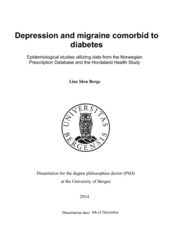Depression and migraine comorbid to diabetes
Doctoral thesis
Permanent lenke
https://hdl.handle.net/1956/8976Utgivelsesdato
2014-12-04Metadata
Vis full innførselSamlinger
Sammendrag
Background: Diabetes, depression and migraine are prevalent diseases in the Norwegian population, and have great impact on patients life in terms of disability. Diabetes is a systemic disease manifesting in a range of organ systems when the body not being able to either produce or effectively use insulin, whereas the exact pathophysiologic mechanisms leading to depression and migraine are not fully known. The understanding of the complexity of disorders in which the etiology and pathophysiology is not fully known might be improved by studying their comorbid conditions. Additionally, given the increasing life expectancy, information on how the risk of comorbid diseases to diabetes varies according to age can be important both in a public health perspective as well as for clinicians in the fields of family medicine, endocrinology, psychiatry and neurology. Aims: Investigate depression and migraine treated with migraine agents as comorbid conditions to diabetes in the general Norwegian population, with emphasis on differences in risk according to age, sex and type of antidiabetic treatment. Methods: Data on dispensions of prescriptions of antidiabetic, antidepressant and/or migraine agents in the total Norwegian population in 2006 was obtained from the Norwegian Prescription Database. As a measure of comorbidity, associations between type of antidiabetic and antidepressant agents according to age-group and sex were investigated in paper 1, while associations between type of antidiabetic agents and migraine agents according to age-group and gender were investigated in paper 3. Selfreported information from the population based survey “Helseundersøkelsen i Hordaland” (HUSK) was used in paper 2 to investigate how the association between diabetes and depression varied by presence and type of antidiabetic treatment in a community sample of middle-aged and older adults, and further study to which extent the association could be explained by known confounders. All studies were crosssectional and the OR was used as a measure of the associations estimated by logistic regression models. Results: Persons using antidiabetic agents had overall age and gender adjusted OR of about 1.5 of using antidepressant agents relative to persons not using antidiabetic agents (paper 1). Highest risk of using antidepressant agents was found for persons in their thirties using oral antidiabetic agents with an OR of about 4.5, and the risk decreased with increasing age to about 1.5 among persons aged 70 years and upwards. Persons using insulin in monotherapy had less variation in risk according to age, OR ranging from 1.7 for persons in their fifties years to 1.3 among persons aged 70 years and upwards. This finding of a higher risk of depression among middle aged persons with diabetes treated with oral antidiabetic agents relative to the non-diabetic population was confirmed in paper 2. The OR for depression defined as symptoms and/or antidepressant treatment for persons with diabetes in their forties using oral antidiabetic agents was attenuated from 3.79 to 2.92 after adjustments for gender, BMI, physical activity, alcohol consumption and education. This increased risk of depression among persons with diabetes contrasts the findings from paper 3, where persons with diabetes had an overall reduced risk of migraine treated with migraine agents relative to the non-diabetic population (age and gender adjusted OR: 0.72). Although young and middle aged persons using oral antidiabetic agents had, in fact, an increased risk of migraine, the risk decreased with increasing age to about the same reduced risk (OR: 0.4-0.6) for all types of antidiabetic treatment for persons aged 60- 69 years. In both paper 1 and 3, no sex-specific differences in risk of the outcome were found. Conclusion: Persons with diabetes have increased risk of depression and decreased risk of migraine treated with migraine agents. While no gender specific differences in risk were found, we found marked variation in risk according to age and type of antidiabetic treatment. The finding of an inverse association between diabetes and migraine could reflect an effect of presence of diabetes over time, inferring with the sensation of migraine pain. If possible preventive strategies in the general population are considered to reduce the prevalence and impact of depression comorbid to diabetes, one should first consider targeting middle-aged persons with diabetes type 2.
Består av
Paper 1: Berge L.I., Riise T, Fasmer O.B., Lund A, Oedegaard K.J., Hundal Ø. “Risk of depression in diabetes is highest for young persons using oral anti-diabetic agents” Diabetic Medicine (2012), 29; 509-514. The article is not available in BORA due to publisher restrictions. The published version is available at: http://dx.doi.org/10.1111/j.1464-5491.2011.03530.xPaper 2: Berge L.I., Riise T, Tell G.S., Iversen M.M., Østbye T, Lund A, Knudsen A.K. “Depression in persons with diabetes by age and antidiabetic treatment: The Hordaland Health Study”. The article is not available in BORA.
Paper 3: Berge L.I., Riise T, Fasmer O.B., Hundal Ø, Oedegaard K.J., Midthjell K, Lund A. «Does diabetes have a protective effect on migraine?» Epidemiology (2013), 24; 129-134. The article is not available in BORA due to publisher restrictions. The published version is available at: http://dx.doi.org/10.1097/ede.0b013e31827623d0
